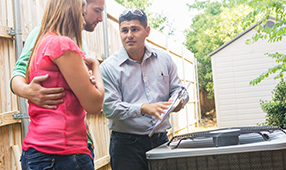Does the cost to heat your home keep giving you the chills? Although you can’t control the weather or the price of fuel, there are several things you can do to reduce your household energy consumption—and save some hard-earned cash—to ensure you and your family stay warm this winter.
1. Install a programmable thermostat
Are you heating an empty house? Then your wallet’s likely feeling the burn. Consider a programmable thermostat ($30-$150). It automatically activates your furnace at a desired time and when indoor temperature dips below a certain degree. “It can prevent wasted energy, but buying the right one and properly programming it are keys to seeing economic savings,” says Maria Vargas, spokesperson for the Environmental Protection Agency’s Energy Star program.
Watch bills shrink—from 5-15%, or up to $180 annually—by setting the thermostat back 10-15° each day for at least eight hours. Seven-day models are the most flexible, as each weekday can be configured differently. Installing one on your own requires some electrical know-how, so unless you’re comfortable with wiring, best to hire a pro.
2. Seal up ducts
If you notice that certain rooms aren’t holding heat and you see cracked and crushed portions of ductwork, start patching things up immediately. The Department of Energy estimates the average homeowner loses 20% of the air traveling through the duct system via leaks, holes and missed connections. And naturally, as air escapes, bills rise. “Sealing leaky ducts saves money while improving a home’s energy performance,” says Bruce Harley, a Massachusetts-based engineer and author of Cut Your Energy Bills Now ($13, amazon.com). Although it’s harder to calculate exact winter bill savings, Harley says that 6-20%* ($132-$440) can be lopped off your annual energy outlay. Because ducts are usually concealed, they can be hard to reach, but not impossible: DIY duct sealing is doable for about $100. If you go with a pro ($500-$800), Harley thinks you’d recoup costs in about two to five years.
Where to begin? Concentrate on the attic (especially if the furnace is up there) and crawlspaces. Don’t worry about the basement ducts. Harley says sealing those saves little.
* Based on the EPA’s estimated $2,200 annual average U.S. household energy outlay.
3. Stop hidden air leaks, then add insulation
You must plug leaks before laying insulation for two reasons: Once insulation is in, it’s no picnic to seal leaks retroactively, and insulation won’t work if air can circulate freely. Both projects—whether executing them yourself or via a Home Energy Rater—could chop up to 20% off your annual heating and cooling bills (both tasks benefit homes year round). “The largest leaks are in attics and basements. Fixing small stuff—weather stripping, window caulking—offers negligible savings,” says Harley.
How do you find “hidden” leaks? Look around chimneys and where ceiling heights and floor levels vary.
And where to add insulation? The attic floor. If attic insulation is below, or level with, floor joists you need more. Professional installation costs about $1 per square foot, including materials ($800-$1,500). Adding your own cuts costs by about one-third.
TIP: R-value identifies insulation’s ability to resist heat flow. Most attics get by with R-38 (12-15 inches) but colder climates probably need R-49 (16 inches).
4. Replace your old furnace with an Energy Star-rated one
“If your furnace isn’t keeping you warm and it’s 15+ years old, it’s probably time to replace it. Depending on where you live, you could cut $200-$300 off your annual bill,” says Vargas. Buy a new Energy Star-rated one with 85% (for oil) or 90% (for gas) efficiency. Any money spent on furnace replacement ($1,500-$4,000) will be regained quickly.
It’s tempting to wait until your current system goes kaput, but don’t do it. “We’re in the midst of peak heating season now,” says Harley, “you’ll only wind up with the spare lying around in some repair guy’s truck. You won’t get the best deal or rating.”
If your furnace is 5-10 years old, chances are it’s already 80% efficient, so stick with it for the time being. If you’re going for that replacement, hire an HVAC contractor who is a member of Energy Star’s Quality Installation program to ensure your system runs properly. “Inefficiency can reduce performance by as much as 30%,” says Vargas.
5. Set the furnace fan to “Auto”
Flipping this simple switch shears $100 to $500 your yearly electric bill. (It may not be the heating bill, but because it’s part of the furnace function, it counts.) A furnace’s fan doesn’t need to run all day. If your house feels stuffy, have the ductwork checked or consider supplementary ventilation instead.
One exception: If you have asthma or allergies, switching the fan to “on” can help with seasonal allergies and filter the dust kicked up while cleaning. Responses vary, so try it to see if it helps you. Just make sure you have a filter than can handle the extra load, and change it often.
If you rent and you pay for heat yourself…
You can still offset your expenses without making permanent changes to your space:
- Keep indoor temperature to 68°. Manually set back the thermostat 8° or more when you’re not home or when you’re sleeping. The larger the setback, the more you’ll save.
- Move furniture off of heat registers to improve heating efficiency.
- Invest in airtight window-AC covers to stop outside air infiltration.
- Close all windows, and keep them closed to prevent heat loss.












